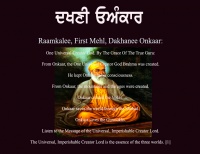Template:AOW133: Difference between revisions
Hari singh (talk | contribs) No edit summary |
Hari singh (talk | contribs) mNo edit summary |
||
| Line 1: | Line 1: | ||
{{aowh|[[Dakhni Oankar]]}} | {{aowh|[[Dakhni Oankar]]}} | ||
[[Image:Dakhnionkaar.jpg|thumb|right|200px|{{cs|[[Dakhni Onkar]] - The [[Bani]] Of [[Guru Nanak Dev]]}}]] | [[Image:Dakhnionkaar.jpg|thumb|right|200px|{{cs|[[Dakhni Onkar]] - The [[Bani]] Of [[Guru Nanak Dev]]}}]] | ||
'''OANKAR''' is a composition of [[Guru Nanak]]'s in the measure [[Ramkali]] in the [[Guru Granth Sahib]]. The full title of the [[bani]] is '''Ramkali Mahala 1 Dakhani Oankaru'''. The title is explained differently by different scholars. The word "Dakhan" means "south" and " | '''OANKAR''' is a composition of [[Guru Nanak]]'s in the measure [[Ramkali]] in the [[Guru Granth Sahib]]. The full title of the [[bani]] is '''Ramkali Mahala 1 Dakhani Oankaru'''. The composition appears in the holy Granth at pages {{SGGSFT|929|938}}. The title is explained differently by different scholars. The word "Dakhan" means "south" and "Onkar" is a reference to "The Creator". | ||
Oankar is composed in the form of an [[acrostic]], each stanza beginning with one of the letters of the script meant for writing [[Sanskrit]]. Some of the sounds of [[Sanskrit]] do not exist in the language used by [[Guru Nanak]]. In such cases, prevalent equivalent sounds are used to represent the letters of the old script. | Oankar is composed in the form of an [[acrostic]], each stanza beginning with one of the letters of the script meant for writing [[Sanskrit]]. Some of the sounds of [[Sanskrit]] do not exist in the language used by [[Guru Nanak]]. In such cases, prevalent equivalent sounds are used to represent the letters of the old script. | ||
Revision as of 14:07, 19 September 2009

OANKAR is a composition of Guru Nanak's in the measure Ramkali in the Guru Granth Sahib. The full title of the bani is Ramkali Mahala 1 Dakhani Oankaru. The composition appears in the holy Granth at pages 929 to 938. The title is explained differently by different scholars. The word "Dakhan" means "south" and "Onkar" is a reference to "The Creator".
Oankar is composed in the form of an acrostic, each stanza beginning with one of the letters of the script meant for writing Sanskrit. Some of the sounds of Sanskrit do not exist in the language used by Guru Nanak. In such cases, prevalent equivalent sounds are used to represent the letters of the old script.
For example, 'j' is used for 'y' and 'b' for 'v'. Oankar opens with verses in praise of God who is remembered as the creator of all that exists; of time with all its different cycles; and of the entire universe. Then follows the verse of rahau (pause) indicating the central theme of the bani : 0 Pandit, why are you involved in the writing of such idle hieroglyphics - write the name of God alone. .....More
